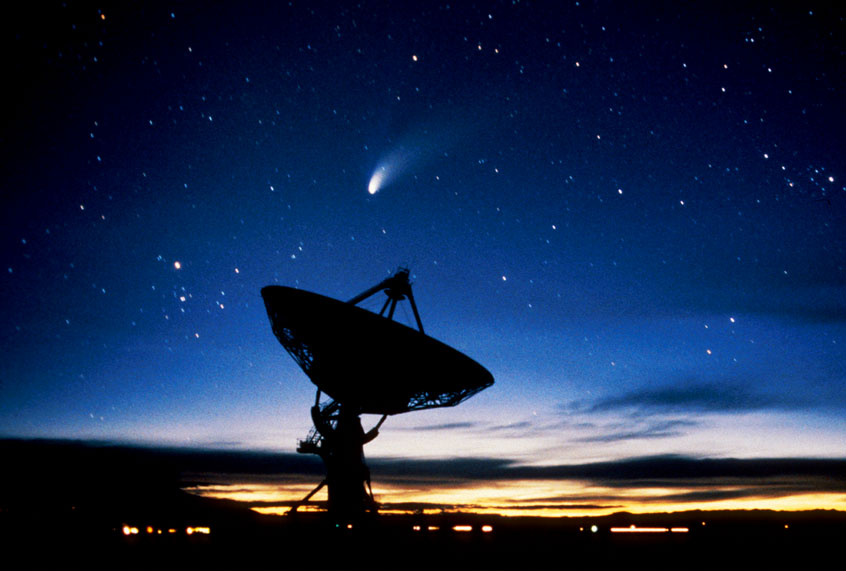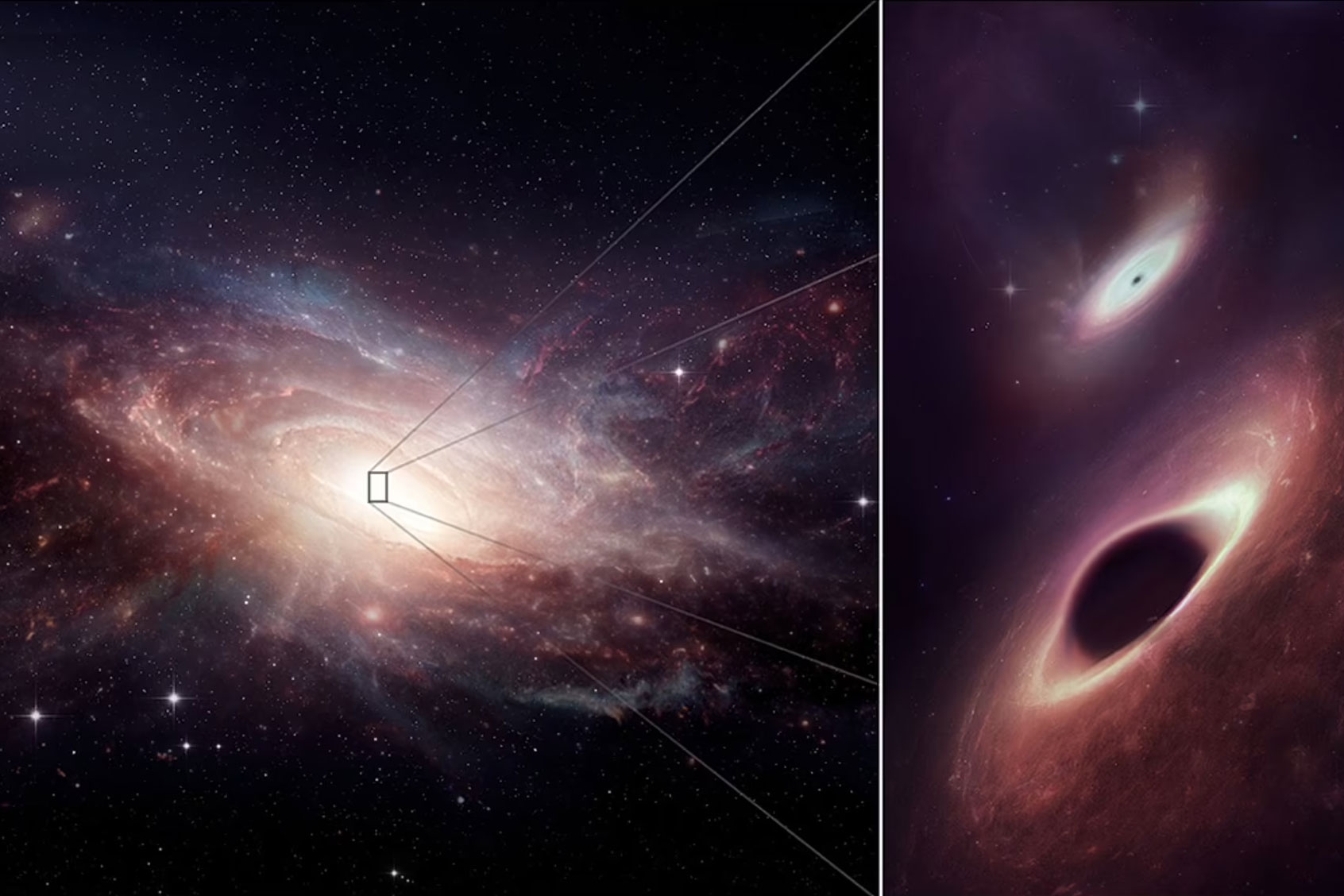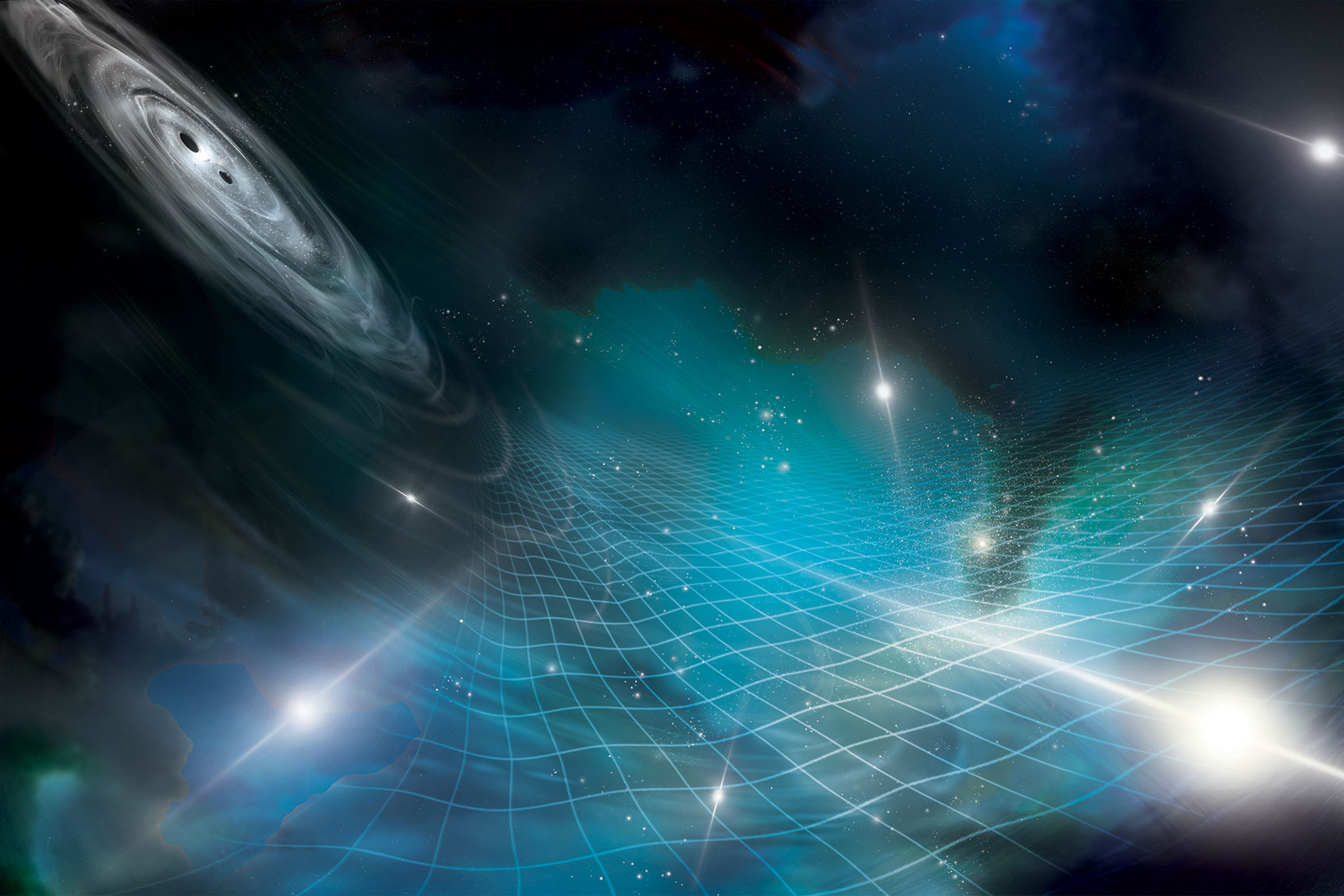On Earth, a visible ripple effect occurs when a stone is thrown into the water. In space, a similar phenomenon happens. However, instead of creating waves that can be seen by the human eye or optical telescopes, the shockwaves that are produced from gravitational energy merging are called gravitational waves.
Physicist Albert Einstein first theorized about the existence of gravitational waves in 1916. But it wasn’t until nearly a century later, in 2015, when the Laser Interferometry Gravitational-Wave Observatory (LIGO) made its first detection of gravitational waves in the universe. Since then, the discovery of gravitational waves have allowed scientists to peer inside neutron stars and discover the wobbliest black hole ever detected.
Yesterday, scientists announced compelling evidence that they’ve discovered a massive “hum” of low-frequency gravitational waves rippling through the universe — and they think it’s highly likely they’re coming from the merging of two supermassive black holes, each of which can range in size from 100,000 to tens of billions of times more massive than our Sun. The news, which can significantly advance our fundamental knowledge of the universe, comes from a series of five papers published on June 28 in The Astrophysical Journal Letters.
“We have evidence of what we call ‘the gravitational wave background,’ which is a hum of gravitational waves coming from all of the gravitational waves in the universe,” Dr. Sarah Vigeland, an astrophysicist at the University of Wisconsin, Milwaukee and co-lead for the Gravitational-Wave Background Paper, told Salon. “Each individual source is giving off a single note, and you can’t hear the individual notes, but it’s a hum, a mesh of gravitational waves all together.”
“We have evidence of what we call ‘the gravitational wave background,’ which is a hum of gravitational waves coming from all of the gravitational waves in the universe.”
The discovery from the North American Nanohertz Observatory for Gravitational Waves (NANOGrav) Physics Frontiers Center is the result of an international collaboration of scientists, who used pulsars to search for the gravitational waves. (Pulsars are highly magnetized, rotating neutron stars spewing beams of electromagnetic energy.)
The first gravitational waves detected by LIGO were high-frequency: fleeting, quick and frequent. The new gravitational waves detected are occurring on longer timescales, from months to decades, and they’re produced by different sources. The discovery was made by scientists collecting over 15 years of observations with the Arecibo Observatory in Puerto Rico, the Green Bank Telescope in West Virginia and the Very Large Array in New Mexico.
 Hale-Bopp Comet behind the Very Large Array (VLA) Radio Telescope near Socorro, New Mexico. (Education Images/Universal Images Group via Getty Images)NANOGrav scientists detected these low-frequency waves by looking to the stars. Together, they observed pulsars which are the ultra-dense remnants of massive supernova stars. Thanks to their rapid spins, they can be detected as rhythmic pulses of radio waves. Vigeland described the pulsars as “clocks” that are spread throughout the galaxy. The clock metaphorically ticks faster or slower, driven by gravitational waves.
Hale-Bopp Comet behind the Very Large Array (VLA) Radio Telescope near Socorro, New Mexico. (Education Images/Universal Images Group via Getty Images)NANOGrav scientists detected these low-frequency waves by looking to the stars. Together, they observed pulsars which are the ultra-dense remnants of massive supernova stars. Thanks to their rapid spins, they can be detected as rhythmic pulses of radio waves. Vigeland described the pulsars as “clocks” that are spread throughout the galaxy. The clock metaphorically ticks faster or slower, driven by gravitational waves.
“By measuring the changes, we can measure the gravitational waves and then we can learn about the sources that are producing them,” Vigeland said. Indeed, scientists have compelling evidence that the source of this gravitational wave is two supermassive black holes merging — a type of explosive collision almost too big and too powerful to imagine.
“Before this discovery, we weren’t even sure that supermassive black holes merged — in fact, there’s a paper from the ’80s that claims that supermassive black holes will never merge because there’s not enough stuff for them to interact with to ever merge within the age of the universe,” NANOGrav scientist Chiara Mingarelli told Salon. “And now, not only do they merge, but we found this signal that comes from hundreds or thousands of these merging supermassive black holes.”
Want more health and science stories in your inbox? Subscribe to Salon’s weekly newsletter The Vulgar Scientist.
But the supermassive black holes are just one candidate for a source of the massive gravitational hum.
“We found the choir, but we don’t know who’s singing in it — the pop stars are the supermassive black holes, they’re the ones that are the most obvious candidates,” Mingarelli explained. “However, there are other potential sources of gravitational waves, like quantum fluctuations in the early universe that were driven to the size of the whole universe by inflation.”
Mingarelli said if quantum fluctuations in the early universe are the source, there would be a “complete paradigm shift” in cosmology.
“We found the choir, but we don’t know who’s singing in it — the pop stars are the supermassive black holes”
“It would mean that we likely lived in an ekpyrotic universe which means that the universe would be undergoing these infinite sequences of expansion and contraction phases forever and ever,” Mingarelli said. “That would be very mind-bending and completely different from the current paradigm.”
Another possible explanation is that the hum is also coming from cosmic strings, which are remnants from the early universe when it cooled down quickly and left cracks that are floating around in space.
 This artist’s conception shows a late-stage galaxy merger and its two newly-discovered central black holes. (ALMA (ESO/NAOJ/NRAO) / M. Weiss, NRAO/AUI/NSF)“They’re these ultra-dense, almost string-like things that are really infinitely small, but very, very dense matter energy filaments that are floating around in the universe,” Mingarelli said. “That’s what’s also really exciting is that the least revolutionary way of interpreting the data is that we found this evidence for hundreds of thousands of merging supermassive black holes, and that is the most boring way of interpreting the result.”
This artist’s conception shows a late-stage galaxy merger and its two newly-discovered central black holes. (ALMA (ESO/NAOJ/NRAO) / M. Weiss, NRAO/AUI/NSF)“They’re these ultra-dense, almost string-like things that are really infinitely small, but very, very dense matter energy filaments that are floating around in the universe,” Mingarelli said. “That’s what’s also really exciting is that the least revolutionary way of interpreting the data is that we found this evidence for hundreds of thousands of merging supermassive black holes, and that is the most boring way of interpreting the result.”
If quantum fluctuations in the early universe are the source, there would be a “complete paradigm shift” in cosmology.
Still, even if it is supermassive black holes causing the hum, such a finding will tell scientists more about how supermassive black holes grow and evolve.
“We know from observations that most massive galaxies have massive or supermassive black holes at their centers,” Vigeland said. “And the properties of those galaxies are related to the properties of their black holes because the two are evolving together — we also know that galaxies merge, but there are still a lot of questions about how these things happen.”
Next, scientists are going to try and measure the power of the gravitational hum which could hopefully lead to confirmation of the source.
“When we get more data, more pulsars, potentially from combining all of our data with Europe and Australia, we might be able to tell very soon, perhaps in the next five years, what exactly is the source of this gravitational background,” Mingarelli said. “It might be a combination of all of these things or maybe none of these things.”
Mingarelli added that scientists will also next map the gravitational waves.
“I think we’re, as theorists, going to be in business for a very long time thinking about all the different sources of these gravitational waves,” Mingarelli said. “And then thinking about how they interact with light and how we can use the interplay between the two to learn more about the physics of the universe.”

